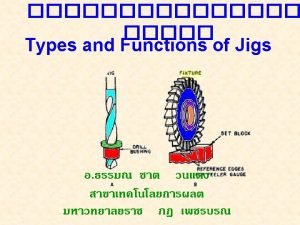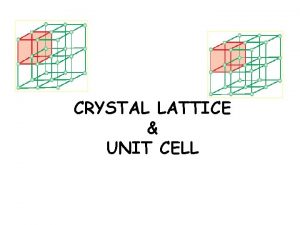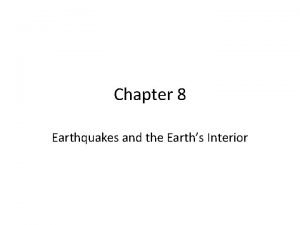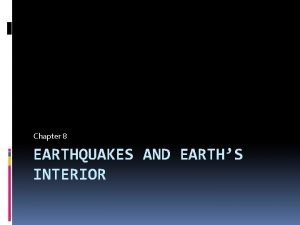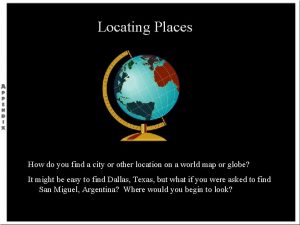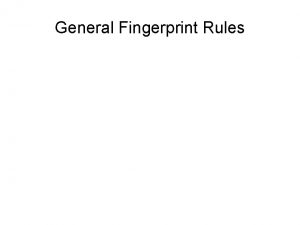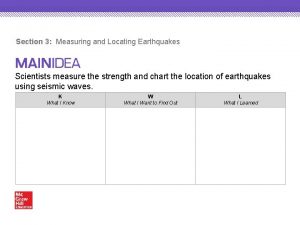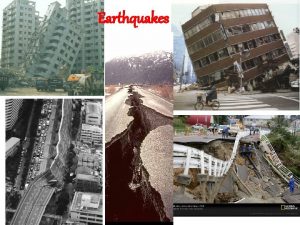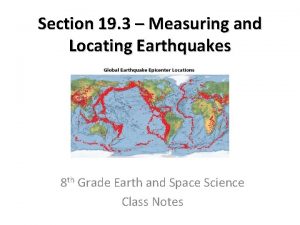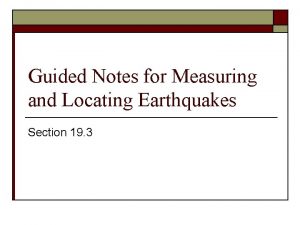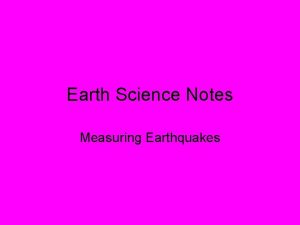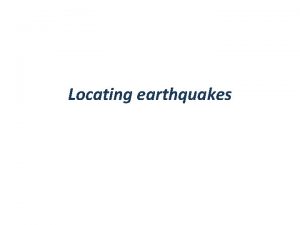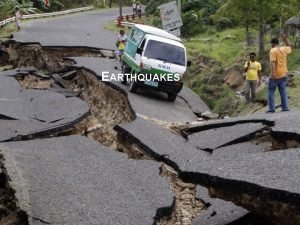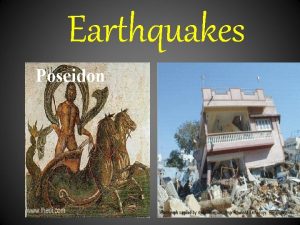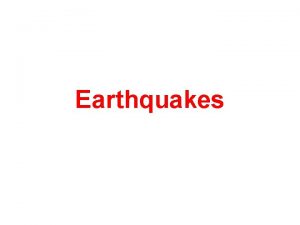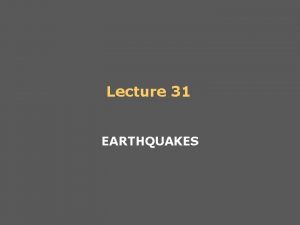Section 3 Measuring and Locating Earthquakes Scientists measure















- Slides: 15

Section 3: Measuring and Locating Earthquakes Scientists measure the strength and chart the location of earthquakes using seismic waves. K What I Know W What I Want to Find Out L What I Learned

Essential Questions • What are earthquake magnitude and intensity and how are they measured? • Why are data from at least three seismic stations needed to locate an earthquake’s epicenter? • Where are Earth’s seismic belts? Copyright © Mc. Graw-Hill Education Measuring and Locating Earthquakes

Vocabulary Review New • • • plot Copyright © Mc. Graw-Hill Education Richter scale magnitude amplitude moment magnitude scale modified Mercalli scale Measuring and Locating Earthquakes

Earthquake Magnitude and Intensity Richter scale • The Richter scale, devised by a geologist named Charles Richter, is a numerical rating system that measures magnitude of an earthquake. • Magnitude is the measure of the energy released during an earthquake. • The numbers in the Richter scale are determined by the height, called the amplitude, of the largest seismic wave. Copyright © Mc. Graw-Hill Education Measuring and Locating Earthquakes

Earthquake Magnitude and Intensity Moment magnitude scale • The moment magnitude scale is a rating scale of the energy released by an earthquake, taking into account the size of the fault rupture, the amount of movement along the fault, and the rocks’ stiffness. Copyright © Mc. Graw-Hill Education Measuring and Locating Earthquakes

Earthquake Magnitude and Intensity Modified Mercalli scale • The modified Mercalli scale is used to measure earthquake intensity on a scale from I to XII. The higher the number, the greater the damage the earthquake has caused. Copyright © Mc. Graw-Hill Education Measuring and Locating Earthquakes

Modified Mercalli scale Concepts In Motion FPO Add link to Animation from p. 540 here. Copyright © Mc. Graw-Hill Education Measuring and Locating Earthquakes

Earthquake Magnitude and Intensity Modified Mercalli scale • The intensity of an earthquake depends primarily on the amplitude of the surface waves generated. Maximum intensity values are observed in the region near the epicenter; Mercalli values decrease to I at distances far from the epicenter. Copyright © Mc. Graw-Hill Education Measuring and Locating Earthquakes

Earthquake Magnitude and Intensity Depth of focus • Earthquakes are classified as shallow, intermediate, or deep, depending on the location of the focus. Shallow-focus earthquakes are the most damaging. Copyright © Mc. Graw-Hill Education Measuring and Locating Earthquakes

Locating an Earthquake • The location of an earthquake’s epicenter and the time of the earthquake’s occurrence are usually not known at first. However, the epicenter’s location, as well as the time of occurrence, can be determined using seismograms and travel-time curves. Copyright © Mc. Graw-Hill Education Measuring and Locating Earthquakes

Locating an Earthquake Distance to an earthquake • Seismologists determine the distance to an earthquake’s epicenter by measuring the separation on any seismogram and identifying that same separation time on the travel-time graph. Copyright © Mc. Graw-Hill Education Measuring and Locating Earthquakes

Locating an Earthquake Distance to an earthquake • To locate the epicenter of an earthquake, scientists identify the seismic stations on a map, and draw a circle with the radius of distance to the epicenter from each station. The point where all the circles intersect is the epicenter. Copyright © Mc. Graw-Hill Education Measuring and Locating Earthquakes

Locating an Earthquake Time of an earthquake • Seismologists can use a seismogram to gain information about the exact time that an earthquake occurred at the focus. The time can be determined by using a table similar to a travel-time graph. Copyright © Mc. Graw-Hill Education Measuring and Locating Earthquakes

Seismic Belts • The majority of the world’s earthquakes occur along narrow seismic belts that separate large regions with little or no seismic activity. • The locations of most earthquakes correspond closely with tectonic plate boundaries. Copyright © Mc. Graw-Hill Education Measuring and Locating Earthquakes

Review Essential Questions • What are earthquake magnitude and intensity and how are they measured? • Why are data from at least three seismic stations needed to locate an earthquake’s epicenter? • Where are Earth’s seismic belts? Vocabulary • Richter scale • magnitude • amplitude Copyright © Mc. Graw-Hill Education • moment magnitude scale • modified Mercalli scale Measuring and Locating Earthquakes
 Chapter 8 section 3 earthquakes and society answer key
Chapter 8 section 3 earthquakes and society answer key In what section of earth do earthquakes happen
In what section of earth do earthquakes happen Food scientists measure food energy in:
Food scientists measure food energy in: Locating pins for jigs and fixtures
Locating pins for jigs and fixtures Recruitment is the process of locating identifying and
Recruitment is the process of locating identifying and Close packing
Close packing Measure air temperature and measure air pressure
Measure air temperature and measure air pressure Chapter 8 earthquakes and volcanoes
Chapter 8 earthquakes and volcanoes Chapter 8 earthquakes and earth's interior
Chapter 8 earthquakes and earth's interior Chapter 8 earthquakes and earth's interior
Chapter 8 earthquakes and earth's interior Locating places
Locating places Rules of selecting delta and core
Rules of selecting delta and core Inductive clamp locating method
Inductive clamp locating method Earth science part d
Earth science part d Four ways of locating the ethical in you
Four ways of locating the ethical in you Champion cooling company is locating a warehouse
Champion cooling company is locating a warehouse



